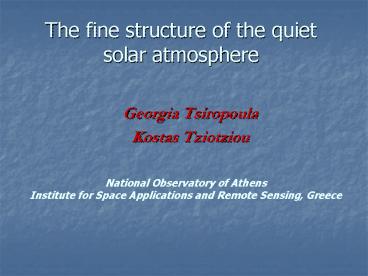The fine structure of the quiet solar atmosphere - PowerPoint PPT Presentation
1 / 17
Title:
The fine structure of the quiet solar atmosphere
Description:
Mottles outline the network boundaries in the chromosphere ... Performed with the Multichannel Subtractive Double Pass (MSDP) spectrograph ... – PowerPoint PPT presentation
Number of Views:26
Avg rating:3.0/5.0
Title: The fine structure of the quiet solar atmosphere
1
The fine structure of the quiet solar atmosphere
- Georgia Tsiropoula
- Kostas Tziotziou
National Observatory of Athens Institute for
Space Applications and Remote Sensing, Greece
2
The chromospheric network outlined by mottles
- Mottles outline the network boundaries in the
chromosphere - There are typically about 30 mottles per network
cell at any one time - The cause of mottles is not known yet with
certainty. - Mottles are very important structures because
they are considered as - a) the disk counterpart of spicules
- b) the principal channels through which mass
and energy is supplied from the lower layers to
the corona and the solar wind
3
Spicules observed at the limb
- Mottles (or spicules) are jets of plasma with
lifetimes of 5 minutes, heights of
5,000-10,000km, diameters of 500-1000 km, speeds
of 20-30 km/s and temperatures of 10,000?
4
Observations
- Performed with the Multichannel Subtractive
Double Pass (MSDP) spectrograph - Provides spectra from which two dimensional
intensity and velocity images at different
wavelengths within a line can be constructed - 50 cm refractor (Pic du Midi Observatory,
Pyrénées) - THEMIS (Observatorio del Teide, Tenerife)
Mein P. AA 381, 271, 2002
5
Ha observations of a rosette with MSDP (50 cm
refractor of the Pic du Midi Observatory)
Tsiropoula, Alissandrakis and Schmieder AA 271,
574, 1993
6
Method of computation
- Use of the Cloud model
- optically thin structures
- constant source function S
- Initial parameters
- ?0
- ??D 0.3 Å
- tmax 1
- S 0.1550.159(P1-C1)/C1
7
Cloud velocities as a function of time along the
axe of a mottleTsiropoula, Alissandrakis and
Schmieder AA 290, 285, 1994
8
Ha observations of a chain of mottles with MSDP
on THEMIS
Tziotziou, Tsiropoula and Mein AA 402, 361,
(2003)
9
Intensity and velocity in different wavelengths
Intensity ?a
Intensity ?a0.48 Å
Intensity ?a-0.48 Å
Doppler ?a0.48 Å
10
Cloud velocities as a function of time along the
axe of a mottle
11
A model for the velocity variations based on
reconnection
Squeezing of opposite polarity fields
Reconnection of magnetic fields
12
MDI continuum images MDI magnetograms
H. Potts (Glasgow University, 2006)
13
Other parameters calculated from the following
relations
Tsiropoula and Schmieder, AA, 324, 1183, 1997
14
Mass flux from fine structures
- Upward mass flux depends on
- fraction f of the solar surface covered by fine
structures at any moment (f 0.05, total number
of mottles 4x105) - the mass density ? (2.2 10-13 g cm-3)
- the axial velocity ?a (?a ?LOS/cos?, ?45o)
- Assuming that at any given moment
- only half of the mottles show upward motion
- only half of the material flows upwards
thus most of the mass does fall down!
Mass outflow from the solar corona 3 10-11 g
cm-2 s-1
Tsiropoula Tziotziou AA 424, 279, 2004
15
Detailed energy flux from fine structures
During the reconnection phase fluxes released
from each event
16
Energy flux from fine structures
- Global energy flux terms estimated assuming
- lifetime of mottles 300 s
- (duration of outflow-downflow of 150 s)
- the area of each event
- birthrate of events (1333 events/s)
14 of the needed energy flux (3 105 ergs cm-2
s-1)
Energy flux provided for heating of corona
B15 G
17
Conclusions
- Several parameters describing mottles can be
obtained from MSDP - Ha spectra
- There are strong indications that mottles are
driven by magnetic - reconnection
- Mass outflow from mottles two orders of
magnitude larger than that - needed for the mass balance of the solar
corona - Most of the mass returns back explaining the
downflows in the network - boundaries observed in the EUV lines
- Energy outflow from mottles accounts for 14 of
the energy budget - of the solar corona (underestimated)
- May be the corona is in fact heated by a wide
variety of mechanisms - that each accounts for some of the required
heating rate. - MSDP powerful instrument providing high spatial
and temporal - resolution spectra in various lines
- THEMIS with its vector magnetogram will help in
giving a definitive - answer on the role of the magnetic field in
the formation of mottles

